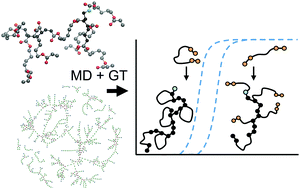Modeling the free-radical polymerization of hexanediol diacrylate (HDDA): a molecular dynamics and graph theory approach†
Abstract
In the printing, coating and ink industries, photocurable systems are becoming increasingly popular and multi-functional acrylates are one of the most commonly used monomers due to their high reactivity (fast curing). In this paper, we use molecular dynamics and graph theory tools to investigate the thermo-mechanical properties and topology of hexanediol diacrylate (HDDA) polymer networks. The gel point was determined as the point where a giant component was formed. For the conditions of our simulations, we found the gel point to be around 0.18 bond conversion. A detailed analysis of the network topology showed, unexpectedly, that the flexibility of the HDDA molecules plays an important role in increasing the conversion of double bonds, while delaying the gel point. This is due to a back-biting type of reaction mechanism that promotes the formation of small cycles. The glass transition temperature for several degrees of curing was obtained from the change in the thermal expansion coefficient. For a bond conversion close to experimental values we obtained a glass transition temperature around 400 K. For the same bond conversion we estimate a Young's modulus of 3 GPa. Both of these values are in good agreement with experiments.



 Please wait while we load your content...
Please wait while we load your content...